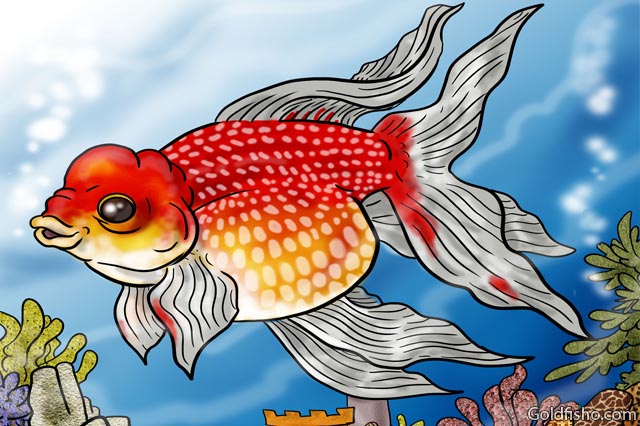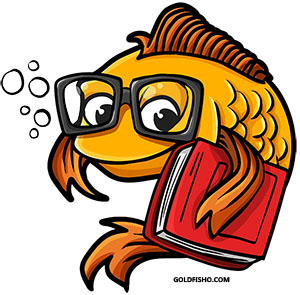The Fanciest Fancy Goldfish-The Pearlscale
The Pearlscale Goldfish is easy to spot amongst other goldfish. She will be the only one dressed in pearls!

Or, so her scales would have you believe!
The Pearlscale Fancy Goldfish is the only goldfish type with bumpy white scales that give the illusion of being covered in pearls or other white beads.
The Pearlscale is also a round-bodied goldfish which can make her resemble a golf ball (which is not as glamorous as being covered in pearls).
These rounded beauties are quite valuable amongst goldfish enthusiasts and collectors alike.
They are not only a beautiful and rare fish, but they are also hardy and can adapt to live in cooler temperatures.
Isn’t she lovely!
The unique scales on these goldfish may be attractive and beautiful, but how did they develop this way?

They were created by calcium carbonate. It is these calcium carbonate deposits that have some researchers wondering if Pearlscale owners (and breeders) should be adding more calcium to a Pearlscale’s diet.
The Pearlscale’s beaded appearance may make her seem untouchable or indestructible but, don’t be fooled!
Her scales are actually a bit delicate.
If a Pearlscale goldfish were to get into a fight with another fish, become ill and demonstrate body rubbing, or if a scale were to be accidentally scraped off while you were handling her then, the beaded scale would not grow back.
Instead, the Pearlscale produces a standard, flat scale in its place.
Where did the Pearlscale Goldfish originate?
The Pearlscale originated in China and Japan.
They have since been bred and live in countries all over the world. “Pearlies” are freshwater goldfish only and can live happily in an aquarium or even an outdoor pond.

Their previously mentioned hardiness means that they can easily adapt to water temperatures ranging from 65º F to 78º F.
The Pearlscale is also one of the smallest goldfish types usually only growing four to six inches in length.
These omnivores can typically live over a decade, or longer if properly cared for.
Are Pearlscale Fancy Goldfish difficult to care for?
The Pearlscale is actually considered one of the easiest types of goldfish to care for.
They are very sociable and friendly towards most fish and even their humans.
In fact, the Pearlscale may often be sought after by collectors but, they make a great “beginner goldfish” for children as well.
The most important detail to remember when owning a Pearlscale is that they should rarely be handled if at all.
Their scales are far too delicate and too unique to these particular fish that it would be a shame to scrape one accidentally off.
As previously mentioned, Pearlscales (like all goldfish) are omnivores in the wild. Wait, you mean they do not eat fish flakes in the wild?
No, they do not. In fact, they eat insects, plants, roots, larvae, and worms.
They will also eat their fruits and veggies! If you wish to have your fancy goldfish happy and healthy for years to come then, you should take into consideration what you are feeding them.
Provide a well-rounded diet.
You can still feed them those fish flakes that you already bought, but spice things up every other day or two.
Mash up some peas or go outside and forage for some mosquito larvae, worms or other small insects.
Your goldfish will welcome the diet change and will be healthier overall. However, if you may want to avoid teaching your children to feed the fish fruits and vegetables.

You may start noticing the scoop of broccoli on their plate from dinner has mysteriously ended up in the fish tank.
The Pearlscale may be a smaller, stockier goldfish but they still need room to grow and swim without bumping into their décor or tankmates.
Be sure to provide your goldfish with a large enough aquarium for all to enjoy.
Most fish enthusiasts will recommend a 50-gallon aquarium, but, if you use common sense and realize you are only bringing home one or two goldfish, then you can feel confident in purchasing a 20 to 30-gallon tank.
The aquarium you choose should be well decorated.
Choose a colorful gravel for the bottom of the tank, some smooth décor, and even some plants (live or fake). Why do they need smooth décor?
The Pearlscale’s beads are delicate and can be accidentally scraped off by other fish, décor and even by you! O
ne way to avoid these goldfish from losing their unique scales is to provide their aquarium with smooth surfaces instead of aquarium castles or dragons that may have sharp edges.

A Pearlscale may be a docile goldfish, but they should only be tankmates with certain other types of goldfish.
While aggression may not be an issue, feeding time might be which is why it is critical that a Pearlscale share her tank with other slow swimming goldfish (i.e. the Lionhead, Oranda, or Ranchu).
An aquarium housing all slow swimmers means that everyone has a fair chance during feeding time. Less competition, more full bellies.
Are there variations to the typical Pearlscale Fancy Goldfish?
Yes! In fact, there is a type of Pearlscale goldfish known as a Crown Pearlscale.
These little guys are very similar to the original Pearlscale goldfish with the exception of the “hood”. A “hood” is a brain-like growth that appears on the top of the fish’s head.
Many other goldfish types naturally have these “hoods” (i.e. the Lionhead or the Oranda).

These fancy goldfish are considered “diggers” and will enjoy digging up any live plants you place inside the tank.
Most goldfish will then eat the roots and nibble on the leaves.
Goldfish are natural munchers so plant nibbling should not be a surprise to an experienced goldfish owner.
The Pearlscale Fancy Goldfish may resemble a golf ball, but she is much fancier than that!
She is a tranquil creature that can handle first-time goldfish owners. She loves a variety of foods in her diet and enjoys sharing her tank with fellow slow swimmers.
Most importantly, she will be the fanciest Fancy Goldfish you will ever own!
Pearlscale Goldfish Questions and Answers

What is a Pearlscale goldfish?
Type: fancy
Colors: red, blue, black, calico, chocolate, red/white
Type of Swimmer: slow
Temperament: peaceful
Single or Twin-tail: twin
Level of Care: great for beginners but with special care due to delicate scales.
What does a Pearlscale goldfish cost?
$6-$10 each
What are compatible tank mates for Pearlscale goldfish?
Because Pearlscales are slow swimmers, never place them together with fast swimming fish. They are best with other slow swimming fish such as Lionheads, Bubble Eyes, Fantails, Butterfly Tails, Ranchus, and Black Moors.
Note: Slow swimming goldfish should not be placed with fast swimming goldfish. Fast swimmers are aggressive eaters at feedings.
Characteristics and Traits of Pearlscale Goldfish
How large does a Pearlscale goldfish get?
4”
What is the lifespan of Pearlscale goldfish?
10-15 years
Diet of Pearlscale Goldfish
What does a Pearlscale goldfish eat?
Pellets
Live food (bloodworms, shrimp)
Fruits & vegetables
Flake food
Tank Requirements for Pearlscale Goldfish
What size tank does a Pearlscale goldfish need?
Minimum: 20-30 gallons
Fish-to-tank Ratio is 1” of fish per 1 gallon of water
What should the water temperature be for a Pearlscale goldfish; and do I need to have a heater for the tank?
65 – 72 degrees (F)
A heater is required to maintain water temperature.
Do I need to have an air stone (air pump) in my Pearlscale goldfish’s tank?
Yes, but avoid having one that is too powerful because pearlscales are slow swimmers and too much water movement will cause them to have trouble swimming. Their scales are very delicate and rapid water movement will cause them to fall off.
Does a Pearlscale goldfish’s tank require a filtration system?
Yes, all goldfish should have a filtration system in their tank.
Be careful that your filtration system’s water intake is not too powerful for the pearlscale because they are slow swimmers and too much movement in the water can be difficult for your pearlscale to tolerate.

